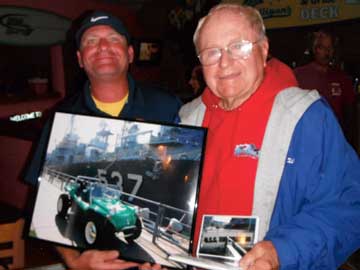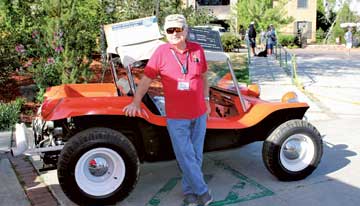Bruce Meyers, creator of the dune buggy, visits WNY enthusiasts
by Peter Soscia

Bruce Meyers, creator of the dune buggy, visits WNY enthusiasts
Bruce Meyers didn’t know what he was creating when he put his first fiberglass body on the Volkswagen Beetle chassis back in 1964. It was called a “Meyers Manx,” but most today know it as a dune buggy. The vehicle that would set desert racing records, inspire auto designers, pop culture, and become a icon in the southern California lifestyle. Although today only dune buggy enthusiasts know the name of Bruce Meyer and despite the great influence his car had on pop culture of the 1960s and 70s, he is not some Malibu billionaire. The story of Bruce Meyer and the dune buggy is one of great creativity, loathing, and learning that wealth isn’t always measured in dollars.
Meyers’ life pre-dune buggy is a quite a story on its own. As a teenager growing up in So-Cal, he worked as a lifeguard, which likely saved his life in World War II. Serving as a sailor on the U.S.S. Bunker Hill, his ship was struck by two Japanese Kamikazes on May 11. 1945. “I had gone over the side to escape the molten aluminum raining down on us from the burning, melting airplanes above us on the flight deck. As an ex-lifeguard I wasn’t afraid of the water. I gave my life jacket to a panicky sailor, rescued a badly burned pilot and towed him for hours,” said Meyers. “To this day I’ll never forget the eyes of the pilot I towed to other rescuers in whale boats from The Sullivans [The boat currently docked in the Buffalo Harbor.] He never spoke, either from horrible facial burns and deep shock, but his eyes implored his gratitude.”


When he returned to California he began living the life of rebel surfer. “I really didn’t know what I was doing, honestly. I was 38 years old at the time and I didn’t pay attention to a lot of the rules,” said Meyers. “I wasn’t a convict or anything like that, but I was hanging out with a lot guys who were Abalone divers. That’s someone who’s a ski bum, and at the end of the snow they come down to the coast and dive for abalone (an edible sea snail,) because they could make a lot of money doing that. I lived within that, and there was such an irreverence for rules and the law by those kind of guys. You kind of start to admire them.”
When you take all these things from Meyers’ life, adding that he spent time attending art school and that his father had race cars, it makes sense that someone like Meyers could design his own vehicle. “I got the idea when I was hanging out with some guys who were making [dune buggies] by hand. Welding up the frames and using the parts from Volkswagen Beetles, I learned what must be done in terms of creating a layout for a dune buggy. I was pretty well sorted out in all the things I needed to do something like this. Here I was with this crazy social life, a former art student, an ex sailor, building fiberglass sailboats, you can put all that into building something like a dune buggy,” said Meyers. In 1964 Meyers produced “Old Red” his first in a long line of “Meyers Manx,” style dune buggies.
Named after the tailless Manx cat breed, to honor the vehicle’s shortened body, Meyers quickly began making “Meyers Manx” a full time production. The Manx style of the dune buggies quickly exploded into not just Californian culture but the nation’s pop culture. It was featured in several movies in the late 60s. In 1968, Elvis Presley rode around in a yellow Manx for the film Live a little, Love a Little, and Steve McQueen drove a dune buggy in The Thomas Crown Affair. According to Meyers it’s not crazy to think that the mainstream auto industry took notice of the buggy sensation as well. “Before I started making the Manx, for the most part cars designed in studios in Detroit, England, Germany, and Australia. Automobiles were made in the country their company was based out of. But all those companies moved and now have a [design] studio in California. There are 22 studios in California that followed the creation of the fiberglass dune buggy,” said Meyers. “So what happened there? Did I get them involved in California? I don’t know, but they weren’t here before I started making the Manx.”
It’s estimated that Meyers’ company produced over 5,500 buggies. However, with popularity comes imitation. “It really became a sensation, and the world of people who copy without any sense of conscience took over and it ruined me eventually,” said Meyers, who stayed in business for seven years, but after several lost cases in the courtroom over the use and imitation of his design, had to close shop. “I went away a sad-sack and I was very unhappy for many years, 21 years to be exact. I spent those years doing everything else. I didn’t want to hear the word dune buggy, I didn’t want to know about it, I ignored the whole thing and went on through life.” said Meyers.
As Meyers walked away from the industry he created, the reach of the dune buggy culture continued to grow and spread worldwide. After 20 plus years of doing everything he could to avoid his creation, Meyers agreed to attend a dune buggy event in France.
“I wound up in France for a big dune buggy event at the racetrack in Le Mans. I led a parade of 1,100 Volkswagens around the racetrack, and the first two or three hundred were dune buggies, full European renditions of what I created. What I found myself doing was beginning to enjoy being kind of the rock star that created all of that, but I was still very unhappy,” said Meyers. “Finally the guy that was my host, Jacky Morel said: ‘You know what you’re doing? Beating yourself up. You piss and moan at all these people that copied your idea.’”
What Morel offered Meyers next helped change the course of his life. According to Meyers it came in the form of a Japanese saying, slightly ironic considering a Japanese Kamikaze had almost ended his life many years earlier. “In all things, something found can be beautiful,” continued Morel. “You don’t like the dune buggy because some guy screwed you over by copying your design, but what you did was make people happy. The two people in the dune buggy are smiling, just think of the people in the dune buggy.”
“So that’s what I started doing,” said Meyers. “I had to pretend for a while, but after a few weeks it started to work. I changed my focus and did the three things Jacky suggested: Start a club, which I did, called the ‘Manx Club.’ Build a new Manx of the 90s, which I did, the Manxter. And write a book, which is still in the works.”
Meyers has found the Manx Club to be the easiest places to find those smiling dune buggy enthusiasts. Based on the west coast, the club now has close 5,000 members.
“The club is the most powerful part, because it absolutely surrounds me with love. All these people they want to hug me, take pictures with me, and have me sit in their cars, so I have this huge love affair with my club,” said Meyers. You will find smaller clubs of Manx enthusiasts across the country, including the “East Coast Dune Buggies” who host the annual “Manx On The Banx” event held in the Outer Banks, NC. It was at this event six years ago that local dune buggy enthusiast Marc Frisicaro, met Meyers for the first time.
“[Meyers] asked me where I was from and I told him Buffalo, and that I was a bar owner [Frizzy’s on Allen St.] He told me there was a ship called the USS The Sullivans that’s stationed in Buffalo, and that it had rescued him at sea during World War Two,” said Fisicaro. “From that moment I struck up a friendship with [Meyers], and I wanted to get him to see the ship again. I started planning a dune buggy event in Buffalo to showcase our town. I thought that Niagara Falls would be a great draw to bring people from all over the country.” The event “Manx Over the Falls” will take place from June 25 to June 28. According the Fisicaro, 55 buggies have pre-registered for the event. Meyers and his wife Winnie, along with 15 other members of the west coast club will be making the trek from southern California. According to Meyers it will be the longest trip he has ever ridden in one of his buggies.
On Friday, the group of buggies will cruise to Niagara Falls to sightsee and ride on the Maid of the Mist. On Saturday, all of the dune buggies will be on display in Buffalo at Front Park from 10am to 1pm.
“It’s open to the public, and is a very family friendly group club. Children can sit in the buggies, people can meet Bruce, and we will have food trucks,” said Frisicaro. At 2pm, the buggies will head over to the Naval Park for a ceremony in Meyers’ honor on the USS The Sullivans. “I’m very excited to see the ship,” said Meyers. “They got the Navy involved in this thing. I have no idea what they’re going to do, but I’m excited.”
Having a worldwide following was not something that Meyers predicted when he built his first Manx in 1964, and without discovering the Manx enthusiasts he very easily could have gone the rest of his life as bitter man. Simply put, Manx and dune buggy enthusiasts have brought just as much love and enjoyment to Meyers as his creation has brought to them.
“I’ve come back to enjoying who I am. People have recognized this whole thing. It’s a lot of fun for me,” said Meyers. “Everything is quite positive. That’s not to say I’m rich, but it has nothing to do with money. It’s mostly about love. The business of the dune buggy is making people happy.”
blog comments powered by Disqus|
Issue Navigation> Issue Index > v14n24 (Week of Thursday, June 18) > Bruce Meyers, creator of the dune buggy, visits WNY enthusiasts This Week's Issue • Artvoice Daily • Artvoice TV • Events Calendar • Classifieds |









 Current Issue
Current Issue